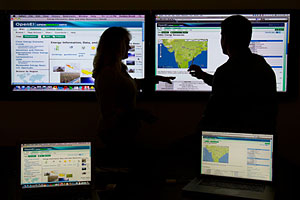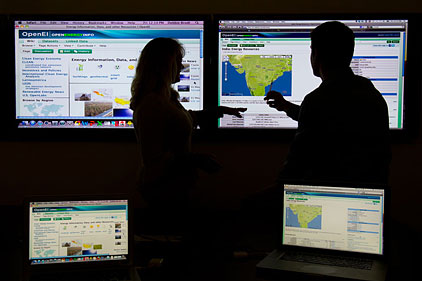 Utility rates from cities all across the United States are now available in one place — the U.S. Department of Energy’s (DOE’s) Open Energy Information platform, or OpenEI.org.
Utility rates from cities all across the United States are now available in one place — the U.S. Department of Energy’s (DOE’s) Open Energy Information platform, or OpenEI.org.Am I paying too much for electricity? Does it make sense for me to put solar panels on my roof? Consumers and businesses are asking, and OpenEI provides answers. Developed by the DOE’s National Renewable Energy Laboratory, OpenEI is where businesses and consumers alike can go to find energy information.
The free site blends elements of social media and Wiki-based technology with previously unavailable information on energy sources and prices. According to DOE, the result is a powerful, collaborative platform that will help government and industry leaders define policy options, make informed investment decisions, and create new businesses.
“Remember the end of Raiders of the Lost Ark, when the Ark was hidden away in a warehouse?” said Debbie Brodt-Giles, NREL’s supervisor of the site. “Many websites are like that — taking something with the power to transform the way we see the world and locking it away. OpenEI is about more than collecting data. We’re about sharing data in ways that transform understanding.”
Crowd-Sourcing Boosts Reliability
DOE said the site uses the power of crowd-sourcing to make energy information even more robust and more accessible. In addition, maps and other visualization tools transform raw data into displays that are easily understood.
“The more people, the more experts, we have contributing data and using the site, the better the site is going to be, the richer the experience is going to be,” Brodt-Giles said. “To have a platform to openly share information that is typically hard to access is a big plus.”
“OpenEI’s unique quality is that it is so open, collaborative, and transparent,” NREL’s Graham Hill said. “The new Utility Rate Database is a great example. We’ve taken information that is typically disparate and difficult to find and we’ve made it easy for anyone to access and understand.”
The new information allows anyone with Internet access to compare kilowatt-hour rates in dozens of cities and zero in on such variables as time-of-use rates, demand charges, and tiered rate structures.
For household consumers, that could mean getting wiser about whether to install rooftop solar panels or finding other ways to lower their energy bills. A farmer in rural Iowa can assess potential profitability of leasing land for wind power development.
Energy investors could use other tools to determine how many wind turbines could be installed on the same property. They can analyze information on rates, wind speed, sunshine (for solar), and incentives to inform their decisions. With OpenEI, said DOE, decision makers can reduce missteps and save time and money.
The new utility-rate data show average consumption rates in the cities. The data illuminate, for example, that air-conditioner-revving warm-weather cities Tucson and Atlanta consume far more energy than cooler-weather cities such as Boston, Denver, and Milwaukee.
Energy Information for All
What are site visitors creating and finding? Among other things:
• For anyone contemplating heating and cooling homes or buildings with geothermal energy, the National Oceanic and Atmospheric Administration provides research about how warm it gets as holes are drilled deeper into the earth.
• Information on how to qualify for local, state, and national incentives for renewable energy systems is accessible thanks to contributions from North Carolina State University.
• Developers can access solar radiation data to find out precisely how much sun they can expect to hit their panels in different locations around the country.
Utilities typically put their rates somewhere on the Internet, but OpenEI ensures that those rates are easily accessible and in data sets that compare costs across a range of cities.
When Energy Secretary Steven Chu announced OpenEI.org, he said, “The true potential of this tool will grow with the public’s participation — as they add new data and share their expertise — to ensure that all communities have access to the information they need to broadly deploy the clean energy resources of the future.”
For more information, visit OpenEI.org.
Publication date: 09/19/2011


Report Abusive Comment